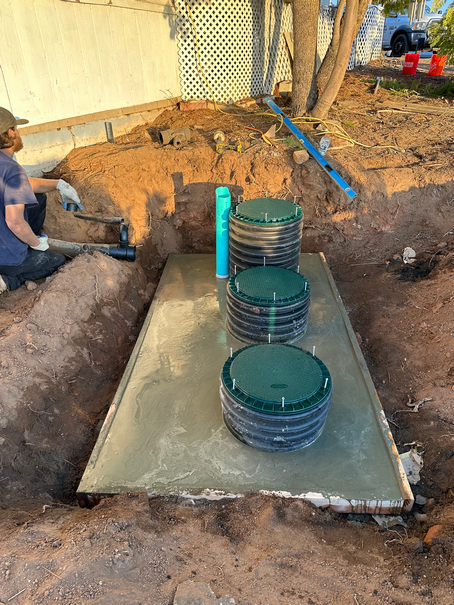
Most septic tank replacement projects take between 3-6 weeks from start to finish, though the actual physical installation requires only 5-7 days under normal conditions. The extended timeline accounts for permit approval, inspections, and potential weather delays that commonly affect outdoor construction projects.
Homeowners planning a septic replacement should understand that this timeline includes several distinct phases, each with specific requirements and potential variables. The complexity of your existing system, local soil conditions, and regulatory requirements in San Diego County all influence the final duration.
Permit Acquisition and Planning Phase
The permit process represents the longest portion of most septic replacement projects. Septic system permits are generally issued within two weeks of submission of a complete application package, though the permitting authority must either approve or deny the planning materials and permit application within 30 days of receipt in most jurisdictions.
A septic system permit is valid for twelve months from the date of issuance and may be granted a one-time extension of 6 months from the expiration date. During this phase, soil evaluations and site assessments occur to determine the appropriate system design for your property’s specific conditions.
Pre-Installation Site Preparation
Before excavation begins, utility companies must mark underground lines through the mandatory “call before you dig” service. This free service typically requires 2-3 business days advance notice. Once installation begins, a minimum of two inspections are required throughout the process.
Site evaluations may face delays during wet weather conditions, as inspectors cannot properly assess soil composition when saturated. This factor can extend the preparation timeline by several days or weeks, depending on seasonal weather patterns.
Excavation and Old System Removal
Excavation and site preparation can be completed within 1-2 days for most residential properties. The excavation process involves carefully removing the existing septic tank while preserving surrounding landscape features when possible.
Rocky soil conditions, high water tables, or limited equipment access can extend excavation time. Digging around tank and disconnecting pipes takes around half a day. Removing and disposing of the old tank adds another half day. Professional contractors coordinate proper disposal of old septic tanks according to environmental regulations.
New Septic Tank Installation Process
Septic tank installation can be completed within 1-2 days for standard residential systems. Larger 2,000+ gallon tanks often take 3-5 days assuming standard site conditions, while smaller tanks install more quickly.
The installation process includes several critical steps that must be completed in proper sequence:
- Tank positioning and leveling in the excavated area
- Connection of inlet and outlet pipes to existing plumbing
- Installation of distribution boxes and connecting lines
- Initial system testing for proper flow and leak detection
- Temporary backfilling for structural support
Professional Installation Standards
Lowering the new septic tank and connecting all plumbing lines takes about 1-2 days for smaller tanks. Larger tanks often require 2-3 days for proper installation and plumbing. Professional installers ensure proper grade and alignment to maintain optimal wastewater flow throughout the system’s lifespan.
Quality installations prioritize long-term performance over speed, as proper tank placement prevents costly future repairs. Licensed installers follow strict local codes and manufacturer specifications during this critical phase.
Drainfield Installation and Connection
When drainfield replacement accompanies tank installation, drainfield installation can take 2-4 days. This process involves creating properly graded trenches and installing perforated distribution pipes according to engineered specifications.
Soil conditions significantly impact drainfield installation duration. Sandy soils allow faster excavation and installation, while clay or rocky conditions require additional time and specialized equipment. The size of your drainfield depends on household size and local regulations.
Inspection and Testing Requirements
Inspections and testing typically take 1-2 days, but the timeframe can vary depending on the complexity of the system and the availability of inspectors. Multiple inspections occur throughout the installation process to ensure code compliance.
Required inspections include pre-installation approval, mid-installation progress checks, and final system approval before backfilling. An approval of the septic system installation will be issued once the system is complete, all required inspections are performed successfully, and all permit conditions have been met.
Final Testing and Certification
System testing involves checking all connections for leaks, verifying proper flow rates, and ensuring adequate drainage. Inspectors confirm that the installation meets local health department standards and environmental protection requirements.
After installation, expect 1-2 days for inspection, testing, and backfilling the site. Final certification allows homeowners to resume normal wastewater usage without restrictions.
Site Restoration and Completion
The final project phase includes backfilling excavated areas, restoring topsoil, and reestablishing proper surface drainage. The final stage involves backfilling the excavated area, restoring the site, and ensuring proper drainage.
Site restoration quality depends on the extent of excavation required and homeowner preferences for landscape restoration. Basic restoration includes proper grading and seed application, while comprehensive restoration may include replacement of mature landscaping affected during construction.
Factors That Can Extend Your Timeline
Several variables can extend the standard replacement timeline beyond the typical 3-6 weeks. Weather conditions represent the most common delay factor, as poor weather conditions can halt excavation and installation work.
Complex system designs requiring advanced treatment components add additional time to the installation process. Properties requiring significant drainfield modifications or system relocations may extend the project by 1-2 weeks beyond standard timelines.
For reliable septic tank replacement services in San Diego, contact Mineo Bros Septic today. Our experienced team provides accurate timeline estimates and professional installation services that meet all local requirements while minimizing disruption to your daily routine.
